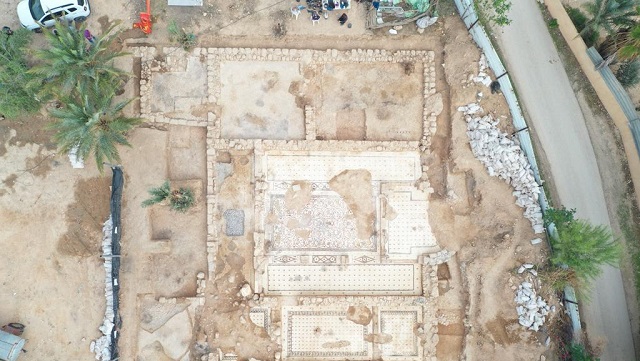A church dating back to the Byzantine era – dated to the 6th Century – was recently uncovered in Jericho. The discovery is said to be remarkable because the church’s floor with a mosaic depicting religious imagery remains largely intact.
The Byzantines were named that by historians for the city of Byzantium. But they knew themselves as the Eastern Roman Empire which was based in Constantinople. That Christian Empire succeeded the Roman Empire after its final fall and lasted for about 1,000 years, ruling over Israel until the rise of Islam and the Arab conquest in the 8th Century.
A mosaic is a tile (usually a floor) image in which many colored tiles are used to form a representation of largely religious imagery such as a menorah. Ancient mosaics have been found all over Israel and mark both Jewish and Christian archeological sites. But Islam considers this type of art to be “iconoclasm” – the depiction of religious figures in a physical form. Judaism prohibits idols or statues and its ancient mosaics did not generally represent Biblical characters and so forth, but not pictures. Christianity allows both.
Will you offer us a hand? Every gift, regardless of size, fuels our future.
Your critical contribution enables us to maintain our independence from shareholders or wealthy owners, allowing us to keep up reporting without bias. It means we can continue to make Jewish Business News available to everyone.
You can support us for as little as $1 via PayPal at office@jewishbusinessnews.com.
Thank you.
When Islam first took over the area the early Muslims converted holy places that belonged to other religions and removed anything that was a form of iconoclasm, which is what makes this find so important.
This church in Jericho is believed to have continued to function as such during the early Muslim period as well. Jericho is located in the West Bank, an area that is today under the control of the Palestinian Authority (PA). But, while the cities and villages there are under full PA control, the open regions are under a joint authority with Israel that can complicate matters when such discoveries are made.
Archeologists said that the floor of the nave of the church has been preserved almost completely, revealing a particularly spectacular mosaic carpet decorated with a pattern of vine braids developing into medallions bearing figures of animals.
The dimensions of the church are about 250 square meters (about 2,600 square feet). At the entrance to the prayer hall lies an inscription in the Greek language more than 3 meters long – containing 5 lines. (Greek was the official language of the Eastern Empire). The inscription mentions “Georgius and Nonus” – the public figures who contributed to the building of the church.
Archeologists added that the “richness of the church” is evidenced by additional findings that were made from materials not found in the area and required a lot of effort to bring them: marble columns and lattice parts made of black bitumen stone.
Its size indicates that this church was one of the largest regional churches of the Christian population. Unlike the churches that were destroyed in the earthquake in 749 AD, the church was abandoned several years before and its doors were deliberately blocked.
The Civil Administration – the Israeli authority that deals with the West Bank – said it will transfer the church structure to the Civil Administration’s mosaic museum on the “Good Samaritan” site – where it will be displayed and preserved for all generations. This site, located west of Jericho, holds a museum and includes ancient dwelling caves, cisterns and a reconstructed Byzantine church. The mosaic museum displays beautiful examples excavated from archaeological sites in Judea, Samaria and Gaza. There is also a fascinating display of artifacts from ancient synagogues in the area.
Archeology staff officer in the Civil Administration, Hanania Hizami said, “I am excited and welcome the historic and amazing discovery, which joins a number of discoveries that the KMT Archeology Unit in the Civil Administration uncovered. We will continue to work for the discovery and preservation of the history of Judea and Samaria.”




